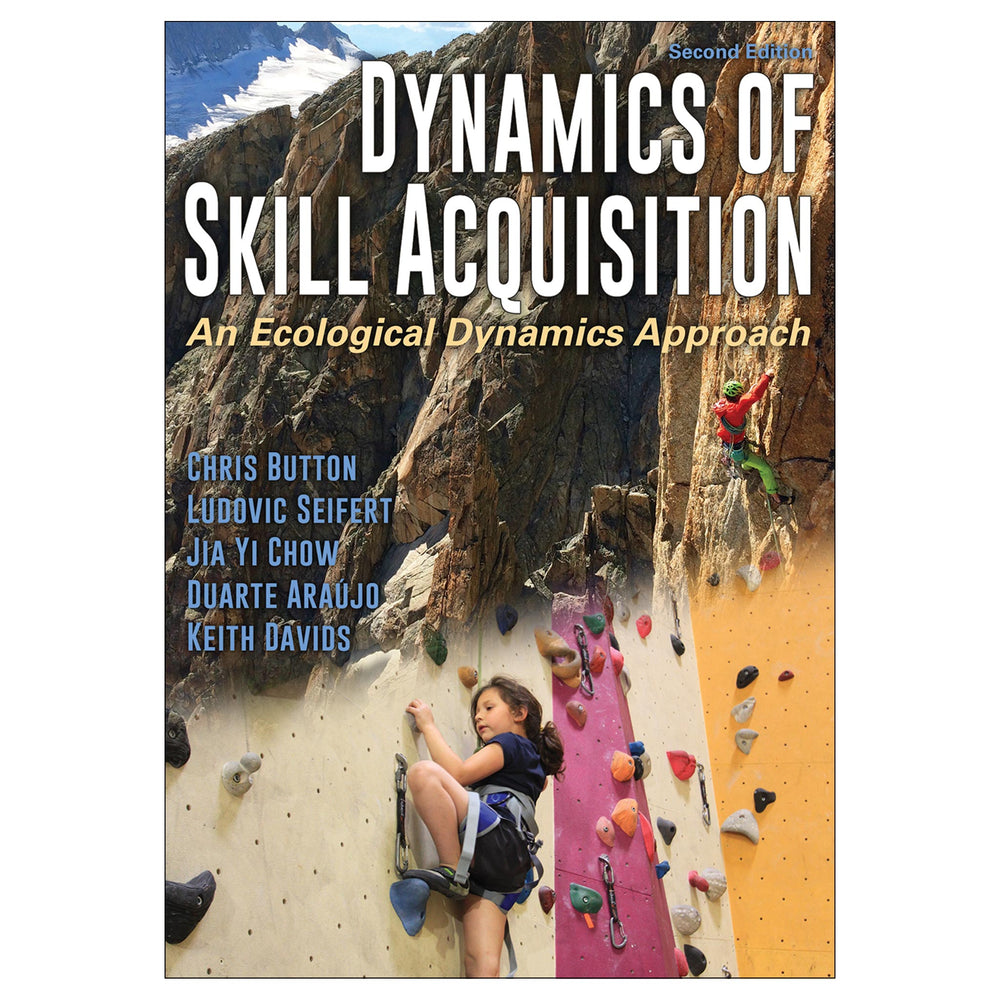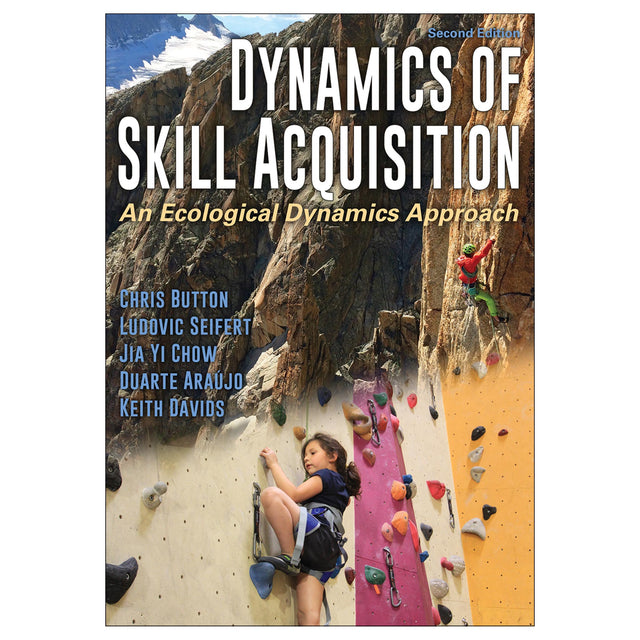Paperback
Dynamics of Skill Acquisition-2nd Edition
An Ecological Dynamics Approach
$98.00 USD
Unit price
/
Unavailable
Paperback
$98.00 USD
$98.00 USD
Paperback
Dynamics of Skill Acquisition, Second Edition, provides an analysis of the processes underlying human skill acquisition. As the first text to outline the multidisciplinary ecological dynamics framework for understanding movement behavior, this heavily updated edition stays on the cutting edge, with principles of nonlinear pedagogy and methodologies from the constraints-led approach.
Students and practitioners across a variety of professions—including coaches, physical educators, trainers, and rehabilitation specialists—will appreciate the applied focus of this second edition. Movement models throughout the text provide examples for visualizing task constraints and enhancing the study and understanding of movement behavior. Athletes and sports teams are presented as specific complex adaptive systems, with information on designing learning environments and adapting programs to foster skill development.
Readers will learn the historical evolution of dynamical systems theory and the ecological dynamics framework. These foundational concepts illustrate the integration between intentional action, cognition, and decision making and their effects on performance and behavior. Complex theoretical concepts are explained in simple terms and related to practice, focusing on the implications of the work of pioneering researchers such as Nikolai Bernstein, Egon Brunswik, James Gibson, Scott Kelso, and Karl Newell. Case studies written by practitioners contain specific examples of the ecological dynamics framework in action, bringing theory to life. By learning how to identify and manipulate key constraints that influence learning skilled behavior, readers will gain insight into practice designs for creating positive learning experiences that enable individuals to develop and learn functional movements.
Throughout the book, learning features guide readers through material with clear direction and focus to improve understanding. Spotlight on Research sidebars provide detailed descriptions of important studies to connect theory, research, and application. Lab activities teach application skills beyond the content, ensuring reader understanding. In addition, chapter objectives, self-test questions, and Key Concept sidebars highlight important concepts in each chapter.
With the study of human movement now bridging many disciplines, including motor development, psychology, biology, and physical therapy, Dynamics of Skill Acquisition, Second Edition, provides a timely analysis of the ecological dynamics framework and presents a comprehensive model for understanding how coordination patterns are assembled, controlled, and acquired. The theoretical roots and development of the ecological dynamics framework provide application strategies for all people with an interest in movement coordination and control.
Students and practitioners across a variety of professions—including coaches, physical educators, trainers, and rehabilitation specialists—will appreciate the applied focus of this second edition. Movement models throughout the text provide examples for visualizing task constraints and enhancing the study and understanding of movement behavior. Athletes and sports teams are presented as specific complex adaptive systems, with information on designing learning environments and adapting programs to foster skill development.
Readers will learn the historical evolution of dynamical systems theory and the ecological dynamics framework. These foundational concepts illustrate the integration between intentional action, cognition, and decision making and their effects on performance and behavior. Complex theoretical concepts are explained in simple terms and related to practice, focusing on the implications of the work of pioneering researchers such as Nikolai Bernstein, Egon Brunswik, James Gibson, Scott Kelso, and Karl Newell. Case studies written by practitioners contain specific examples of the ecological dynamics framework in action, bringing theory to life. By learning how to identify and manipulate key constraints that influence learning skilled behavior, readers will gain insight into practice designs for creating positive learning experiences that enable individuals to develop and learn functional movements.
Throughout the book, learning features guide readers through material with clear direction and focus to improve understanding. Spotlight on Research sidebars provide detailed descriptions of important studies to connect theory, research, and application. Lab activities teach application skills beyond the content, ensuring reader understanding. In addition, chapter objectives, self-test questions, and Key Concept sidebars highlight important concepts in each chapter.
With the study of human movement now bridging many disciplines, including motor development, psychology, biology, and physical therapy, Dynamics of Skill Acquisition, Second Edition, provides a timely analysis of the ecological dynamics framework and presents a comprehensive model for understanding how coordination patterns are assembled, controlled, and acquired. The theoretical roots and development of the ecological dynamics framework provide application strategies for all people with an interest in movement coordination and control.
Audience
An upper-level undergraduate or graduate textbook for courses in human movement and skill acquisition. A professional reference for movement practitioners and scientists, including teachers, coaches, trainers, physical educators, physical therapists, rehabilitation specialists, sport scientists, psychologists, biomechanists, sport analysts and physiologists. Chapter 1. Athletes and Sports Teams Considered as Complex Adaptive Systems
Chapter 2. Physical Constraints on Coordination: Dynamical Systems Theory
Chapter 3. Informational Constraints on Coordination: An Ecological Psychology Perspective
Chapter 4. Intentionality, Cognition, and Decision Making in Sport
Chapter 5. Understanding the Dynamics of Skill Acquisition
Chapter 6. How Interacting Constraints Support a Nonlinear Pedagogy
Chapter 7. Redefining Learning: Practical Issues for Representative Learning Design
Chapter 8. Designing Individualized Practice Environments
Chapter 9. Practice for Sports Teams
Chapter 10. Modified Perceptual Training for Athletes
Chapter 11. Practitioners as Designers
Chapter 12. Expertise and Talent Development in Sport
Chapter 2. Physical Constraints on Coordination: Dynamical Systems Theory
Chapter 3. Informational Constraints on Coordination: An Ecological Psychology Perspective
Chapter 4. Intentionality, Cognition, and Decision Making in Sport
Chapter 5. Understanding the Dynamics of Skill Acquisition
Chapter 6. How Interacting Constraints Support a Nonlinear Pedagogy
Chapter 7. Redefining Learning: Practical Issues for Representative Learning Design
Chapter 8. Designing Individualized Practice Environments
Chapter 9. Practice for Sports Teams
Chapter 10. Modified Perceptual Training for Athletes
Chapter 11. Practitioners as Designers
Chapter 12. Expertise and Talent Development in Sport





